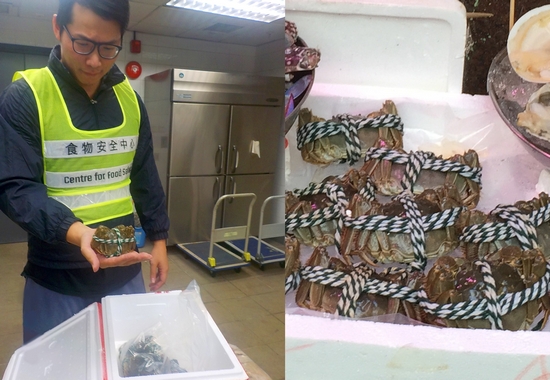
Food Safety Focus (135th Issue, October 2017) – Incident in Focus
Hairy Crabs and Food Safety
Reported by Dr. Henry MOU, Medical Officer,
Risk Management Section,
Centre for Food Safety
The Incident
In 2016, three samples of hairy crabs from the Mainland were detected to have dioxin-like polychlorinated biphenyls (DL-PCBs) exceeding the Centre for Food Safety (CFS)’s action level. Import into and sale within Hong Kong of hairy crabs from the two concerned aquaculture farms were suspended. This article introduces the current control measures of hairy crabs adopted by the CFS for ensuring the food safety.
Dioxins and DL-PCBs
Dioxins and DL-PCBs are environmental pollutants with similar toxic effects. Dioxins are ubiquitous in the environment, occuring natually (e.g from volcanic eruptions and forest fires), as by-products of combustion and various industrial processes. DL-PCBs, on the other hand, were more related to industrial activities. Dioxins, once released, contaminate soil surfaces and aquatic sediments in streams, rivers and lakes where hairy crabs live. Hairy crabs scavenge for food at the bottom of these habits. Dioxins and DL-PCBs bioaccumulate along the food chain. The long-term cumulative risk of dioxins to health includes developmental problems in children and reproductive problems in adults as well as cancer-causing in humans.

Hairy crabs are inspected and tested for chemicals at import, wholesale and retail levels.
Local Food Safety Regulations
The Public Health and Municipal Services Ordinance (Cap. 132) stipulates that all foods for sale and are intended for human consumption should be fit for human consumption. Hairy crabs imported should comply with the local requirements including veterinary drug residues (such as nitrofurans and malachite green), metallic contaminants (such as cadmium and mercury), synthetic hormones, colouring matters (such as Sudan dyes), pesticide residues, and dioxins and DL-PCBs.
In Hong Kong, dioxins and DL-PCBs in foods have been closely monitored by the Food and Environmental Hygiene Department. After considering international practices and local dietary habits, the CFS established an action level of 6.5 picograms (pg) toxic equivalent per gram in edible part of hairy crabs in 2016.
Import Control
Hairy crabs sold in Hong Kong came mainly from the Mainland, from registered aquaculture farms that have undergone quality inspection by the relevant Mainland authorities. Hairy crabs were also imported from other places, such as the Netherlands, Taiwan and Japan especially in recent years. Health certificates, if any, issued by the issuing authorities of the exporting countries/regions accompanying the consignments would be subjected to inspection by the CFS.
Regarding the contamination of hairy crabs by dioxin and DL-PCBS, a Dutch study revealed that hairy crabs from some polluted rivers in the Netherlands may contain dioxins and DL-PCBs at levels that health risks cannot be excluded. Since then, the relevant authority of the Netherlands prohibited the harvesting of hairy crabs from the polluted areas in the Netherlands as reported in the study and their monitoring programme.
Food Surveillance
As part of its Food Surveillance Programme, the CFS conducts surveillance on hairy crabs during hairy crab season. The CFS will follow up on the unsatisfactory results, including conducting risk assessment, tracing the source and distribution. Based on the risk assessment result of the unsatisfactory hairy crab sample, its importation from the concerned aquaculture farm might be suspended. The CFS would instruct the local importer concerned to remove the affected products from shelves, stop sale or initiate a recall of the affected products. The CFS would issue press release and trade alert immediately to inform the public and the trade as well as inform the relevant authority of the exporting country/place for follow-up actions at source.
As of noon of 16 October 2017, 84 hairy crab samples, including 11 samples tested for dioxins and dioxin-like PCBs, have had satisfactory test results. One unsatisfactory sample imported from the aquaculture farm in Taoyuan, Taiwan, collected at the import level, was found to contain dioxins and dioxin-like PCBs at a level of 9.86 pg toxic equivalent per gram of the food sample, exceeding the action level adopted by the CFS.
Key Points to Note:
- The long-term cumulative risk of dioxins and DL-PCBs to health includes developmental problems in children and reproductive problems in adults as well as cancer-causing in humans.
- The CFS established an action level of 6.5pg toxic equivalent per gram in edible part of hairy crabs.
- The import control strategy and seasonal surveillance programme on hairy crabs would be continued in 2017.
Advice to the Trade
- Source hairy crabs from reliable suppliers with health certificates issued by relevant health authorities.
- Impose effective internationally recognised food safety controls through the supply chain and ensure the compliance.
- Keep abreast of hazards in food and take appropriate steps to provide only safe food to consumers.
Advice to the Public
- Buy hairy crabs from reliable shops or restaurants.
- Ask the retailer to show the health certificate.
- Take a balanced and varied diet which includes a wide variety of fruit and vegetables so as to avoid excessive exposure to chemicals from a small range of food items.

